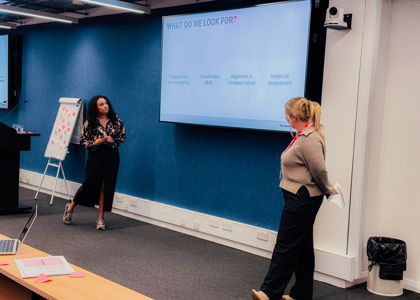How To Create A Fashion Portfolio
When it comes to creating a fashion portfolio, the format and structure you choose are highly personal, but it's crucial to consider the industry you're in or aspire to be part of, as well as the ease of sharing your portfolio with others in the industry. We've compiled our top tips on creating a fashion portfolio:
Tools and Software
The tools you use to create your portfolio will depend on your chosen medium. For a physical portfolio, you may need traditional art supplies such as sketching pencils, paints, or photography equipment. If you're creating a digital portfolio, you can use graphic design software like Adobe Photoshop, Illustrator, or online portfolio platforms that offer pre-designed templates such as Canva.
Format
The format of your portfolio can vary based on your preferences and the type of work you want to showcase. Some common formats include physical portfolios (printed and presented in a binder or portfolio case), digital portfolios (hosted on a website or presented as a PDF), or a combination of both.
Structure
The structure of your portfolio should be organised and easy to navigate. Here's a suggested structure:
- Cover: Start with an eye-catching cover page that includes your name and a relevant visual element that reflects your work.
- Introduction: Begin with an introduction or opening statement that provides an overview of your background, skills, and artistic approach. This section helps set the tone for your portfolio.
- Projects/Works: This is the main section where you present your best work. Divide it into separate sections for each project or type of work. Include a title or description for each project and provide some context or background information.
- Descriptions: Accompany each project or work with a brief description or caption that explains the concept, process, and any relevant details. This helps viewers understand your creative intent and the story behind each piece.
- Visuals: Include high-quality visuals of your work. For physical portfolios, use professional photography or scans of your artwork. In digital portfolios, make sure your images are well-lit, properly cropped, and showcase the details of your work effectively.
- Skills and Experience: Include a section highlighting your relevant skills, education, certifications, and any professional experience that is applicable to your field. This can include internships, freelance work, or collaborations. You may wish to do this in the form of a CV.
- Contact Information: Provide your contact information, including your email address, website, and social media handles. Make it easy for people to reach out to you.
Portfolio Length
The ideal length for a portfolio can vary depending on the complexity and extent of your work. As a guideline, aim for a portfolio that is concise and focused. Generally speaking, portfolios range from 10 to 30 pages. It's important to prioritise quality over quantity and ensure that each page showcases your best work.
Tailor your portfolio to the audience
Remember to tailor your portfolio to your target audience and field. Researching industry standards and seeking feedback from professionals in your field can also provide valuable insights for creating an effective portfolio.
Keep in mind that your portfolio is a dynamic representation of your skills and style, so it's important to regularly update and refine it as you create new work or gain more experience.





